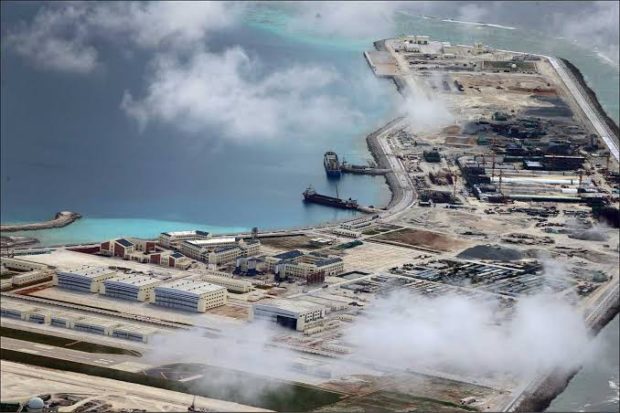New photos of China-made islands in Spratlys show scale of military buildup

Structures on Subi (Zamora) Reef
MANILA, Philippines — A new set of highly detailed photographs of China’s man-made islands in the Spratly Islands in the South China Sea captures the scale of its military buildup on these far-flung rocks and reefs, some of them located within the Philippines’ exclusive economic zone.
“Some mobile assets (the aircraft, missile boats, and missile launcher trucks) show they are now operating actively as armed bases for intelligence, surveillance, and reconnaissance,” said maritime security expert Jay Batongbacal who examined the photos taken by Getty Images photojournalist Ezra Acayan on Oct. 25 likely during a maritime patrol.
Batongbacal told the Inquirer that there appeared to be “only minor cosmetic changes to the fixed structures,” based on the new images, as compared to the surveillance photographs published by the Inquirer in 2018.
Among the mobile assets identified by defense news site The War Zone on its initial analysis of the photos were two Type 022 Houbei-class catamaran fast attack missile craft on Panganiban (Mischief) Reef, which it said could carry up to eight YJ-83 subsonic anti-ship missiles, along with their bow-mounted 30mm H/PJ-13 Gatling-type guns, despite its relatively small size. Another was a KJ-500 airborne early warning and control aircraft on Kagitingan (Fiery Cross).
Four-door garage-like structures on the three biggest islands — Panganiban, Kagitingan, and Zamora (Subi) — could be used “to house, service and rapidly deploy transporter-erector-launchers used to fire surface-to-air, anti-ship, and/or surface-to-surface missiles,” it wrote.
Images of Panganiban, one of the three islands with a 3-km runway, offered an idea of the extent of the airfield, The War Zone said. “During a contingency operation, it could be loaded up with dozens of combat aircraft, from fighters to bombers.”
Shipping route
The seven Chinese-occupied islands featured runways, helipads, radars, hangars, missile shelters, gun turrets, and close-in weapon systems, among others. Since 2013, Beijing’s artificial island building spree has created 3,200 acres of new land, according to the Asia Maritime Transparency Initiative.
China, through its illegal nine-dash line, claims almost all of the South China Sea while the Philippines, Vietnam, Malaysia, Brunei, and Taiwan have overlapping claims. An arbitration court ruling rejected these claims in 2016, but Beijing does not recognize the ruling.
“With the complex installations seen on its archipelagos of artificial islands, China presents a solid deterrent to challengers of its claims and could rapidly shut down, or at least directly challenge, any movements through the region under threat of activating all its capabilities that can be deployed on and around its island outposts,” said The War Zone.
According to Batongbacal, all ships and aircraft belonging to the Philippines and other countries that come within range of China’s weapons will be “very vulnerable” if they have no counter-weapons.
The Chinese bases could also be used to cut off the shipping route used for delivering supplies to Taiwan and Japan. For the South China Sea, they are forward bases from which to launch attacks beyond the First Island Chain, and prevent access from the Indian and Pacific Oceans, he said.
Asked to comment on the images, Arsenio Andolong, spokesperson for the Department of Defense, said that the department was “constantly monitoring activities being undertaken in the West Philippine Sea through the conduct of legitimate maritime and aerial patrols.”
“We have also deployed troops to ensure the well-being of our citizens in the Municipality of Kalayaan,” he said, referring to the Philippine-occupied features.
The Philippines has nine small military detachments over these waters, which it calls the West Philippine Sea, while other claimants aside from China have also maintained their own outposts. Some features occupied by the Philippines like Ayungin (Second Thomas) and Pag-asa (Thitu), are located a few nautical miles away from Chinese outposts.
Last week, US Ambassador MaryKay Carlson renewed a call for Beijing to comply with the 2016 arbitral award on the West Philippine Sea, as she reiterated that Washington would support its treaty ally against attempts to advance “unlawful maritime claims.”
RELATED STORIES
EXCLUSIVE: New photos show China is nearly done with its militarization of South China Sea
China military planes land on PH reef














